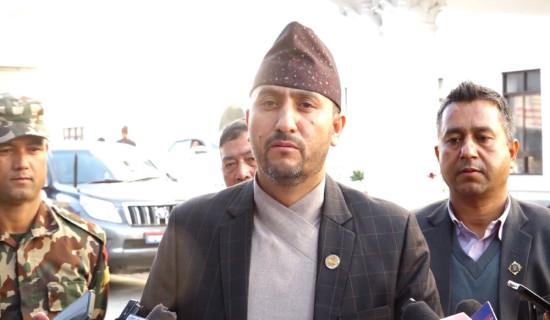- Monday, 15 December 2025
'Decade Of Investment' Boosts Agriculture
Agriculture has long been the backbone of Nepal's economy, employing a significant portion of the population and contributing to food security. Despite its importance, the sector struggles with inadequate investment, receiving an average of only 3 per cent of the federal budget. The contribution of agriculture to GDP has declined from 30.3 per cent in 2013/14 to around 24 per cent now, while over 62 per cent of households depend on it. Challenges include climate change, lack of agricultural inputs, low access to finance, and rural youth migration, leaving more than 30 per cent of farmland barren. This reliance on food imports threatens food security and undermines domestic agriculture, exacerbated by rising global food prices.
Additionally, limited investment stifles essential infrastructure and technology development, preventing modernisation and commercialisation of the sector. Farmers rely on outdated farming techniques and practices while facing difficulties in accessing quality seeds, fertilisers, modern irrigation systems, and advanced agricultural methods that could enhance yields and reduce food imports. Additionally, the shortage of agricultural labour in rural areas, coupled with challenges posed by climate change and adverse weather conditions, further hampers progress.
The inadequacy of quality production materials has kept the average growth rate of the agricultural sector to just 2.9 percent over the past decade.
Investment in agriculture
Recognising the urgent need for significant investment in the agriculture sector, the government has declared the period from 2024 to 2034 as the "Decade of Investment in Agriculture" in this fiscal year's budget. The current administration, led by Prime Minister KP Sharma Oli, has prioritised increasing investment from public, private, cooperative, and donor agencies to boost agricultural development. In line with this goal, the Ministry of Agriculture and Livestock Development has developed a comprehensive concept paper designed to initiate an "Investment Decade" in agriculture. This strategic framework aims to enhance agricultural production and productivity while addressing critical challenges related to food security, economic resilience, and sustainable development, says ministry spokesman Dr. Hari Bahadur K.C.
The concept paper outlines a vision for the overall transformation of the agricultural sector. The scheme will be implemented in coordination with federal, provincial, and local governments, as well as the private sector, cooperatives, community organisations, and development partners. It will identify special areas for agricultural development at the three-layer government, considering geographical suitability, market potential, and ecological conditions.
The Decade of Investment aims to modernise farming practices, enhance infrastructure, and support innovation to ensure that agriculture can meet future demands. The private sector can play a crucial role in economic development, which boosts high morale for investment in agriculture, thereby creating a vibrant investment ecosystem.
This year, the country recorded approximately 98 per cent of its paddy plantation. However, production is expected to decline due to damaging rainfall during the last week of September. Heavy rainfall from September 26 to 28 triggered floods and landslides, inundating paddy fields and devastating farmlands across two dozen districts. According to a report from the Ministry of Agriculture and Livestock Development, the floods and inundation have caused over Rs. 6 billion in damages to the agricultural and livestock sectors.
The floods completely destroyed paddy planted on 58,476 hectares of land in more than 20 districts. This year, approximately 1.37 million hectares of the total 1.39 million hectares designated for paddy were cultivated. Farmers have incurred losses of Rs. 3.5 billion in rice production, and it is estimated that national rice output will be significantly affected by the extensive damage caused by the floods. Around 4.26 per cent of the total paddy cultivated area was damaged. Rice contributes about 15 per cent to the agricultural GDP and 5 per cent to the overall GDP. It is estimated that rice production will be reduced by at least 230,000 tonnes due to the destruction of fields covering 58,476 hectares, with an average productivity of approximately 3.9 tonnes per hectare.
The current government has prioritised the formation and amendment of regulations, addressing the challenges faced by farmers, and ensuring the effective distribution of chemical fertilizers. In the first 100 days, the ministry has made significant progress, including the preparation of a concept paper for a Decade of Investment in Agriculture, budget management, and the listing and payment of dues to dairy farmers. Within three months, an additional 135,000 farmers have been registered, bringing the total to 1.91 million, with an aim to complete the listing of farmers within the current fiscal year.
The ministry has prepared an amendment draft for the Farmer Registration Procedures, which is yet to be approved. To simplify the distribution of subsidised fertilisers, a revised proposal for the Fertiliser Distribution Management Guideline 2077 has been developed and will be submitted to the Ministry of Finance and the Ministry of Law, Justice, and Parliamentary Affairs for consent.
Addressing the recurring issue of fertiliser accessibility during the planting season, the ministry has completed the tender process for importing 460,000 tonnes of chemical fertilisers, funded by the budget allocated for the current fiscal year. It has allocated Rs. 27.95 billion for fertiliser subsidies, which constitutes nearly half of the total agriculture budget—Rs. 57.29 billion. So far, around 155,000 tonnes of fertilisers have been imported, and approximately 129,000 tonnes, including stock from the previous fiscal year, have been distributed in three months.
Subsidies to farmers
The District Treasury Controller Office has released Rs. 1.44 billion to provide subsidies to sugarcane farmers, who will receive Rs. 70 per quintal based on the previous fiscal year's sugarcane crushing.
The deposits in the farmers' bank accounts commenced before the Dashain festival. The subsidy procedure for crop and livestock insurance premiums for the year 2081 B.S. has been approved and is currently being implemented.
During this period, approximately 37,611 livestock insurance policies and 333 crop insurance policies have been issued. An electronic system for managing crop and livestock insurance has also been established and is in official use. The ministry conducted 2,746 market monitoring and inspection visits over three months. Altogether 13,061 samples of fruits and vegetables imported at customs checkpoints were tested for pesticide residues using the RBPR method.
The Dairy Development Corporation (DDC) received a loan of Rs. 600 million from the government, which was distributed to dairy farmers, amounting to Rs. 1.13 billion. The ministry initiated payments for the dues of dairy farmers who have not been compensated for milk sold to the DDC since December of last year. On September 25, the ministry established an eight-member working group, coordinated by the secretary of the National Farmers' Commission, to develop a restructuring and business improvement plan for the DDC. Lastly, the Seeds Regulation has been approved by the Council of Ministers, another significant achievement for the agro sector.
(The author is a journalist at The Rising Nepal.)
















